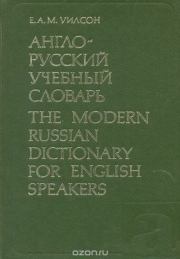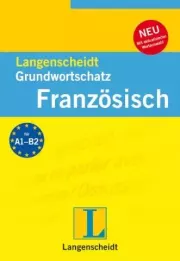Э Уилсон , Э Ли , Дж. Макиэр , Е. А. М. Уилсон - Англо-русский учебный словарь. Для лиц, говорящих на английском языке
 | Название: | Англо-русский учебный словарь. Для лиц, говорящих на английском языке |
Автор: | Э Уилсон , Э Ли , Дж. Макиэр , Е. А. М. Уилсон | |
Жанр: | Словари, Иностранные языки | |
Изадано в серии: | неизвестно | |
Издательство: | Русский язык | |
Год издания: | 1984 | |
ISBN: | неизвестно | |
Отзывы: | Комментировать | |
Рейтинг: | ||
Поделись книгой с друзьями! Помощь сайту: донат на оплату сервера | ||
Краткое содержание книги "Англо-русский учебный словарь. Для лиц, говорящих на английском языке"
Словарь содержит около 75 000 слов и выражений, употребительных в современном английском языке. Предназначается как для иностранного читателя, изучающего русский язык, так и для русского читателя, изучающего английский язык. В словаре широко представлена словосочетаемость, дается много иллюстративных фраз и предложений, которые помогут читателю в овладении современной разговорной лексикой. Словарь окажет значительную помощь студентам и преподавателям языковых вузов.
Читаем онлайн "Англо-русский учебный словарь. Для лиц, говорящих на английском языке". [Страница - 5]
There is a wealth of illustrative phrases, couched in the language of "everyday** and these should help to give the student the feel of spoken Russian.
COVERAGE (LEXIS)
The nature of the dictionary has determined the vocabulary. Very full treatment has been given to the few basic words which figure so largely in our daily use—do, get, give, go, make, put, way, etc., as also to prepositions. Special attention is paid to verbs in combination with prepositions or adverbial particles, which are usually translated by Russian verbal prefixes. These are of the first importance to the student. All the commoner senses of the selected English headwords have been covered, but not necessarily rare ones. Thus for instance when a verb is nearly always used in the transitive form, although the intransitive form exists (or vice versa), the rare usage may be ignored.
To 'save space, abstract nouns and adverbs derived directly from adjectives are not given, e.g. tender adj нежный is given, but not tenderness n нежность, nor tenderly adv нежно.
In groups of cognate words, such as biological, biologist, biology, one or more of the terms may be omitted. Similarly English words which are translated by direct transliteration into Russian are often omitted, e.g. morgue морг, or nymph нимфа. In such cases it will be easy for the student to form or find these for himself.
THE LANGUAGE
Emphasis has been given to the spoken language—both everyday colloquial uses and more specialized uses, e.g. the' language of the committee man. Many of the examples are given in the second person singular indicating exchanges between friends of the. same age, or colleagues of the same rank, or members of a family. A strong distinction is made between colloquial expressions and slang, the latter being included only if it is well established, partly because it can date so quickly, partly because it is hard to appreciate its exact tone in a foreign language. Translations are as far as possible stylistically matched. Where there is no true equivalent of an English expression such as ghost writer, it has seemed better to omit the term rather than to offer explanations or cumbrous circumlocutions, which the student could equally well form for himself if need arose.
ILLUSTRATION
Translation by single words seldom enables the student to use these words in a living context. The illustrations are designed to provide such a context. They also show the difference between the two languages in construction and grammar where rules apply. For example, translation of the English predicative adjective does not always in Russian follow directly from the attributive form, e.g. unconnected sentences несвязные фразы, but the two events are quite unconnected эти два события никак не связаны между собой.
Illustrations also serve to familiarize the student with Russian word combinations and word order, and with the typical flow and rhythm of the Russian sentence, none of which can be deduced a priori. Though word order in both languages is flexible, varying according to emphasis, nevertheless there are standard patterns of order where the two languages differ, e.g. she walked in her sleep last night сегодня [NB] ночью он ходйла во сне. Again the invariable English cadence is supply and demand, but the Russians prefer спрос и предложение.
LAYOUT
All English words and phrases are printed in bold type. Indicators (of style, meaning, etc.) are printed in italics. Long entries are divided; each division is numbered, begins on a new line and is inset. But short entries which can be taken in at a glance, may contain no divisions, even when these would be justified semantically.
ORDER WITHIN AN ENTRY
Usually an entry or division starts by giving one or more general translations. Examples then follow grouped around the general translations in the order in which these were' given; then come examples which are not covered by any of the general translations.
Within an entry or division, direct uses are given first, followed by specialized, colloquial direct, figurative and then figurative colloquial uses. In big entries figurative uses are often treated in a separate division. Attributive uses of a noun come at the end of the entry or of the appropriate division.
The divisions of an entry normally depend on the different shades of meaning in which the English headword is being used, but, exceptionally, divisions may be given over to translations of a single English meaning by particular Russian constructions, if it seems that to do so will make for a clearer understanding by the English learner.
Transitive and intransitive uses of a verb are treated separately. In the case of the larger verbs, uses with prepositions or adverbial particles are given separately as headwords in alphabetical order, and they are similarly divided into transitive and intransitive uses.
TRANSLATION OF HEADWORDS
A number of entries open with a colon and proceed straight to the examples. This happens when no sufficiently general translations of the headword suggest themselves. A translation which only suits one use of the headword is always shown in context: it is misleading to give one-time uses in a way that suggests that they can be widely applied.
Again Russian definitions or explanations of the headword are avoided. The student is looking for Russian equivalents usable (when properly inflected) in live context. To translate some (pronoun) by некоторое количество is an explanation, and it is most unlikely to be the correct translation of some (pronoun) in any given context. Again приветствие is a correct translation of welcome (noun), but, in the four common examples chosen in the text, it is not used once. In such a case the student is less likely to be misled if the entry opens immediately with translations of the common contexts, or of the set combinations in which the headword is normally used.
GRAMMATICAL INDICATIONS
Each headword is followed by its grammatical label in abbreviated form: n — ndun, adj—adjective and so on.
The constructions following a Russian word are always shown, either in abbreviated form, e.g. любовь к + А привыкнуть к + D or+ inf, or they may be shown in examples, and often in both ways.
A number of explanatory notes on grammar and
--">Книги схожие с «Англо-русский учебный словарь. Для лиц, говорящих на английском языке» по жанру, серии, автору или названию:
 |
| Лангеншайдт - Немецко-французско-русский учебный словарь Жанр: Словари Год издания: 2012 |
 |
| Евгений Фронтикович Гаглоев - Аграфена и Братство говорящих котов Жанр: Детские приключения Год издания: 2014 |


